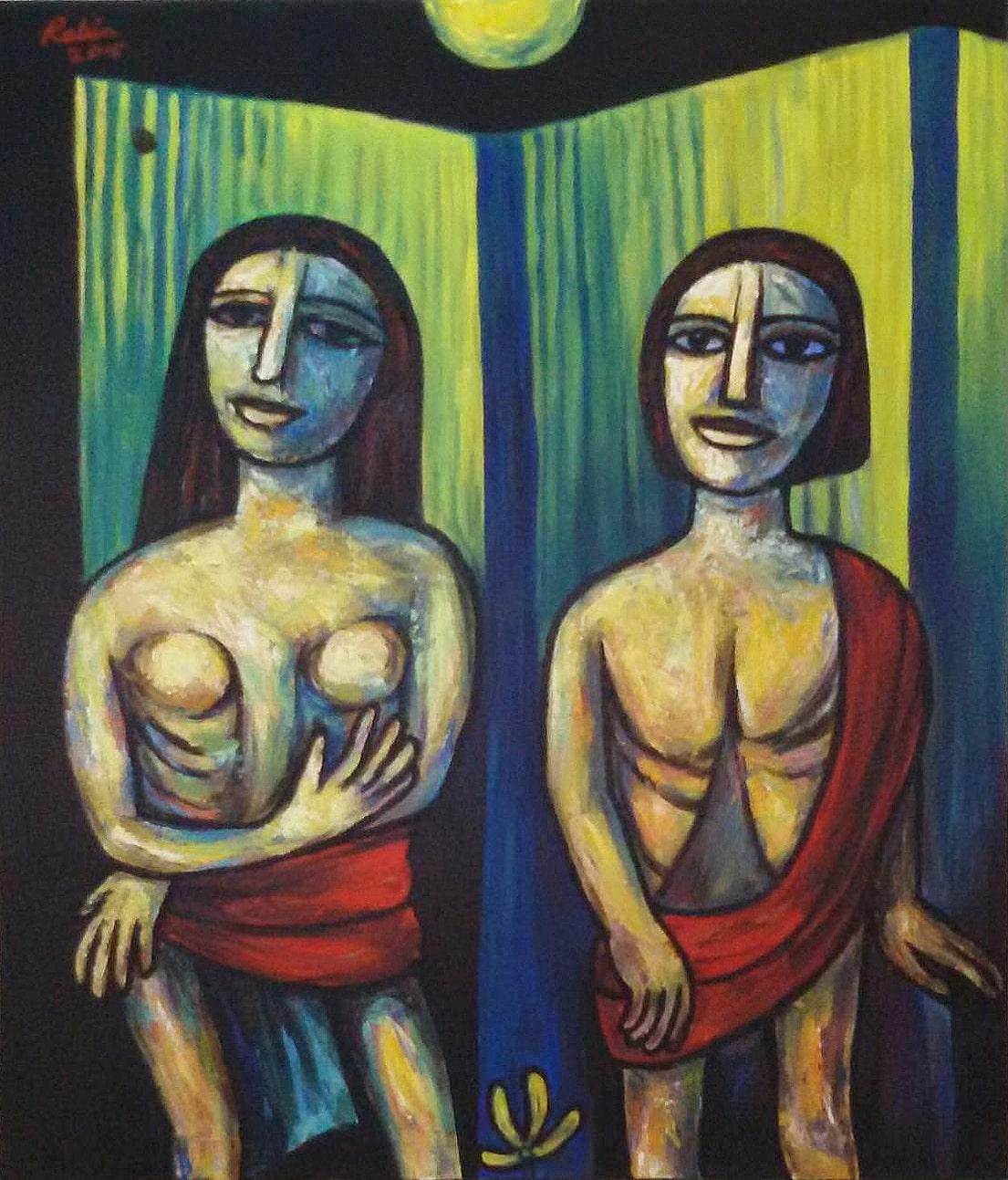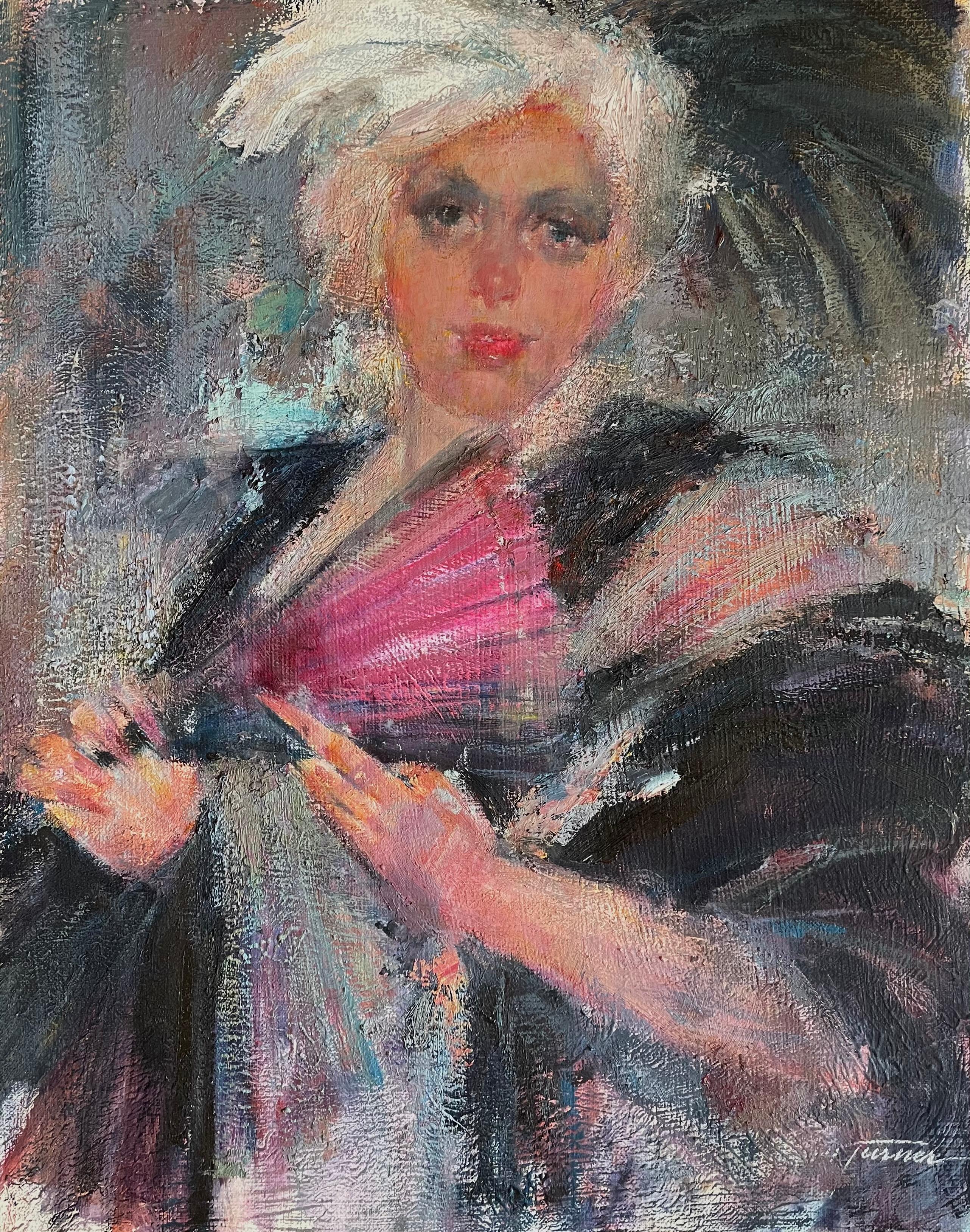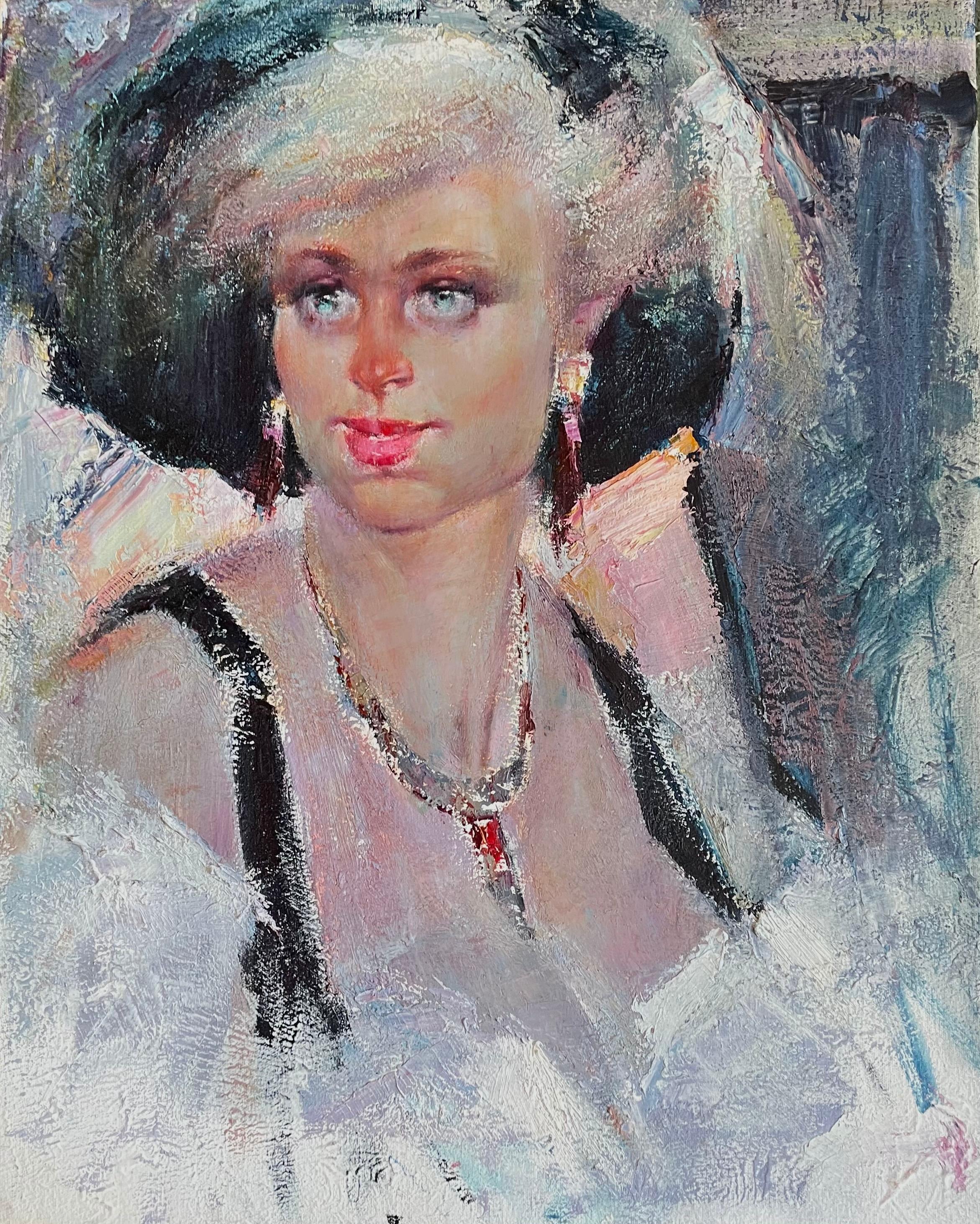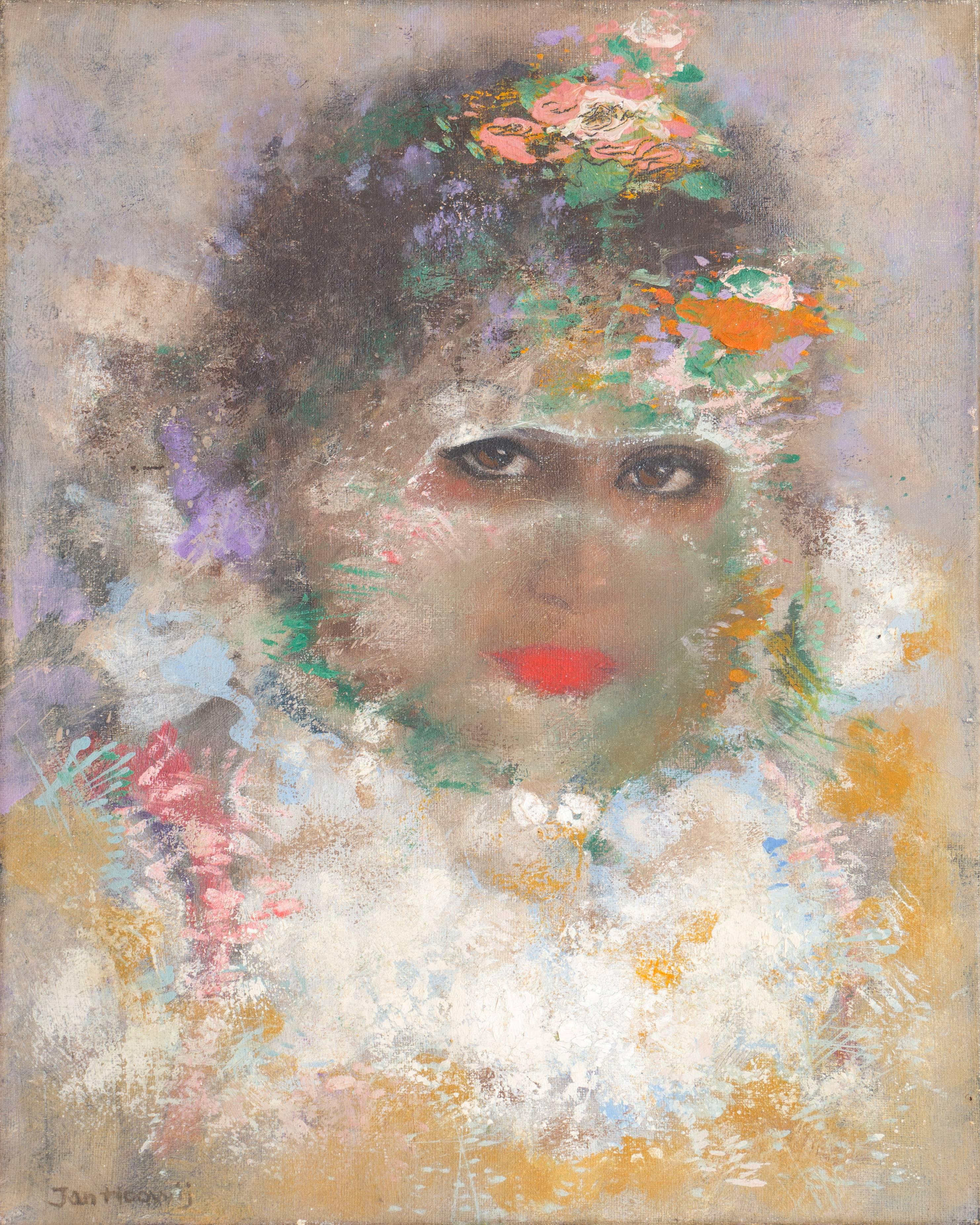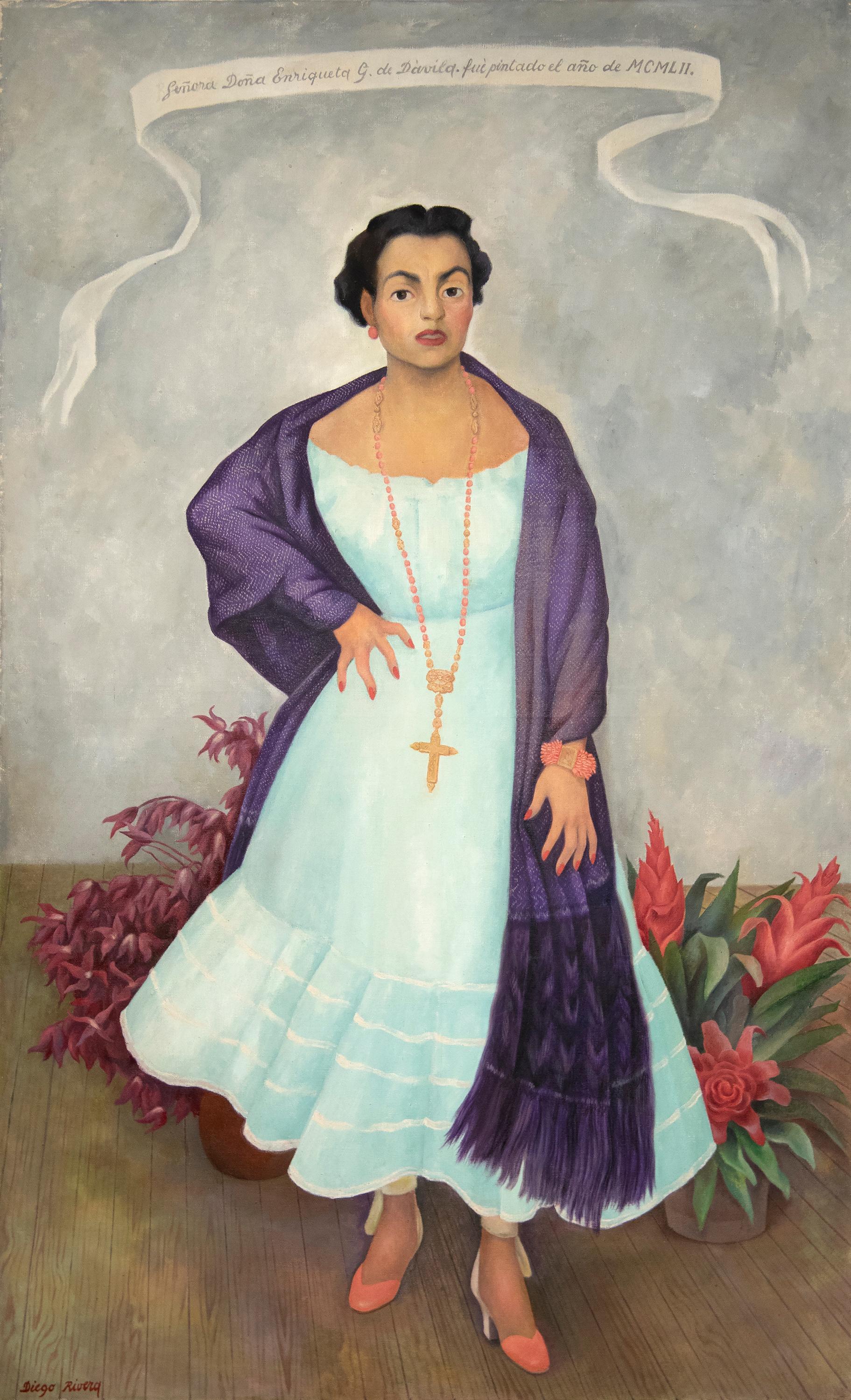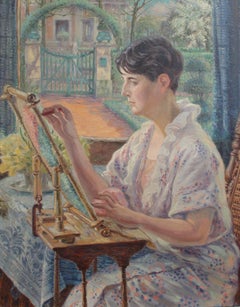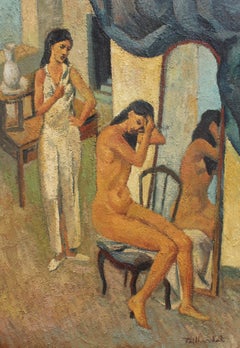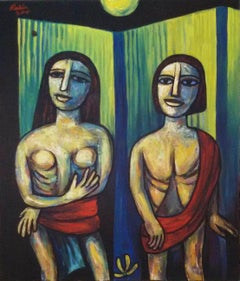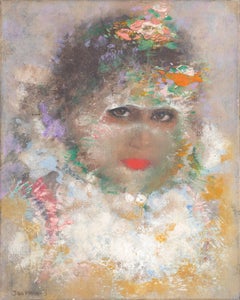Items Similar to The Fishermen
Want more images or videos?
Request additional images or videos from the seller
1 of 20
Anna CostaThe Fishermencirca 1970s
circa 1970s
About the Item
'The Fishermen', oil on canvas, by Anna Costa (circa 1970s). Cassis is a small, Provencal fishing village in southern France, located about 45 minutes east of Marseille and 45 minutes south of Aix-en-Provence. Known for its calanques (large rocky limestone coves), beaches, and beautiful port overlooked by a medieval chateau, Cassis isn’t exactly the image that comes to mind when you think of a typical town in Provence. But stepping into Cassis is like stepping into an impressionist painting, and nowhere is that more true than Cassis’ harbour, the Port de Cassis. In the 1960s and 70s, it was less popular for visitors than it is today. The artist's depiction here reveals a sleepy autumnal day in the port, the fishermen on the quay surveying the arrival of their workmate rowing in on a dinghy. Costa created this image using huge, audacious brushstrokes in both vibrant and muted colours. Overhead, the blue sky hosts large clouds nudged by Provence's northerly winds and the artist's brush. What is very clear is that Costa's artworks' charm springs from their naive simplicity and unassuming subjects.
Overall, the quality of light in Provence is one of the region's most distinctive features, and it has played a significant role in shaping the cultural and artistic identity of the area. The colours in Costa's artworks are famous for their richness and vibrancy, and the quality of light in the region plays a big part in this. Please enjoy the many photos accompanying the listing. It is in good overall condition commensurate with age and is newly framed with a French-style linen slip. Upon request a video will be provided. The stamp of the artist's atelier appears on the back side of the stretcher frame as is the case with the vast majority of her works.
About the Artist: Anna Costa (approx: 1922-2022) painted in her Provençal village in the Cavaillon area from the 1940s until the 1970s. Upon her passing, her estate released her art into the market where dealers around the world are clambering for her works. Costa's art is characterised by its bright colours and strong naive style which make them instantly recognisable. This style is called Provençal Colourism. It is a regional art movement that emerged in the South of France in the early 20th century. It is also characterised by bright and bold colours, as well as strong contracts between light and shadow. The movement drew inspiration from the natural beauty of the region including its landscapes, people and traditions.
Dimensions With Frame:
H 61.5 cm / 24.2"
W 76 cm / 39.9"
Dimensions without Frame:
H 49 cm / 19.3"
W 64 cm / 25.2"
Anna Costa (approx: 1922-2022) painted in her Provençal village in the Cavaillon area from the 1940s until the 1970s. Upon her passing, her estate released her art into the market where dealers around the world are clambering for her works. Costa's art is characterised by its bright colours and strong naive style which make them instantly recognisable. This style is called Provençal Colourism. It is a regional art movement that emerged in the South of France in the early 20th century. It is also characterised by bright and bold colours, as well as strong contracts between light and shadow. The movement drew inspiration from the natural beauty of the region including its landscapes, people and traditions.
About the Seller
5.0
Platinum Seller
Premium sellers with a 4.7+ rating and 24-hour response times
Established in 2016
1stDibs seller since 2017
496 sales on 1stDibs
Typical response time: <1 hour
- ShippingRetrieving quote...Shipping from: London, United Kingdom
- Return Policy
Authenticity Guarantee
In the unlikely event there’s an issue with an item’s authenticity, contact us within 1 year for a full refund. DetailsMoney-Back Guarantee
If your item is not as described, is damaged in transit, or does not arrive, contact us within 7 days for a full refund. Details24-Hour Cancellation
You have a 24-hour grace period in which to reconsider your purchase, with no questions asked.Vetted Professional Sellers
Our world-class sellers must adhere to strict standards for service and quality, maintaining the integrity of our listings.Price-Match Guarantee
If you find that a seller listed the same item for a lower price elsewhere, we’ll match it.Trusted Global Delivery
Our best-in-class carrier network provides specialized shipping options worldwide, including custom delivery.More From This Seller
View AllPortrait of a Man
By Yvonne Guégan
Located in London, GB
'Portrait of a Man', oil on canvas, by Yvonne Guégan (circa 1970s). This is not a portrait of the reclusive billionaire, Howard Hughes. Regrettably, we d...
Category
1970s Modern Portrait Paintings
Materials
Canvas, Oil
$1,996 Sale Price
30% Off
The Cyclists Rest Stop in Honfleur
Located in London, GB
'The Cyclists Rest Stop in Honfleur' by Jean-Marie Luc Blanpain, oil on canvas (circa 1970s). The artist's depiction of the terrace of the well known Honfleur restaurant, 'Au Relais ...
Category
1970s Modern Portrait Paintings
Materials
Canvas, Oil
$1,357 Sale Price
20% Off
Woman by the Window with Embroidery Frame
By Franz Ludwig Kiederich
Located in London, GB
'Woman by the Window with Embroidery Frame', oil on canvas, by Franz Ludwig Kiederich (circa 1930s). A delightful depiction of a woman, comfortable...
Category
1930s Post-Impressionist Portrait Paintings
Materials
Canvas, Oil
$1,710 Sale Price
30% Off
Woman in Front of the Mirror
Located in London, GB
'Woman in Front of the Mirror', oil on canvas, by Vincent Tailhardat (circa 1990s). A nude woman seated in front of a mirror grooms herself while en...
Category
1990s Portrait Paintings
Materials
Canvas, Oil
$1,738 Sale Price
20% Off
The Banana Plantation Guadeloupe
Located in London, GB
'The Banana Plantation Guadeloupe', oil on canvas, by Robert Humblot (1959). In 1959, when the artist visited French Guadeloupe, he painted several colo...
Category
1950s Portrait Paintings
Materials
Canvas, Oil
$2,546 Sale Price
25% Off
The Banana Plantation Guadeloupe II
Located in London, GB
'The Banana Plantation Guadeloupe II', oil on canvas, by Robert Humblot (1959). The second in a series of artworks completed in 1959 when the artist vis...
Category
1950s Portrait Paintings
Materials
Canvas, Oil
$2,546 Sale Price
25% Off
You May Also Like
Couple, Oil & Acrylic on Canvas by Modern Indian Artist “In Stock”
By Rabin Mondal
Located in Kolkata, West Bengal
Rabin Mondal - Couple ; Oil & Acrylic on Canvas
42 x 36 inches ; 2015 (unframed) ( Typically frames to be 48 x 42 inches with a 3 inch frame )
(Shipment will be in roll form)
Style : Mondal`s works are mainly figurative. He paints in bold strokes and creates tableaux, whose themes are universal. The faces of his figures stare at you out of the canvas, strange and pensive, but also strong and defiant. Not yet beaten, surviving by sheer force of spirit. He mostly uses dense pigments in blacks and reds, with only occasional moss green and turquoise colors seeping through.
About the Artist & his works :
Born : Rabin Mondal (1929 – 2019) was born in Howrah, Kolkata.
Education :
1959 : Completed his Art Appreciation Course, Ashutosh Museum, Kolkata University, Kolkata.
1956-58 : Attended Evening Classes, Indian College of Art and Draughtmanship, Kolkata.
1952 : Bachelor of Commerce, Vidyasagar College, Kolkata University, Kolkata.
Art Career : The industrial belt of Howrah, with its inherent tendency towards violence, anguish and suffering influenced him deeply, and found its way into his works. So did ugly street battles fought by political parties. Mondal discovered that his artistic temperament was out of keeping with the hostile environment and situation.
Besides a debilitating knee injury in his childhood created a sense of isolation in the artist, which also finds expression in his canvas. He says what saved him from sheer madness was his talent in art. In 1949, he joined the Vidyasagar College of Art in Kolkata. At that time, a festival of French artists was being held in the city. It exposed him to the works of French modernist artists. Prior to this, he had no exposure to the international art world. He was only familiar with different schools of Indian art, particularly the Bengal school.
As a young painter, Mondal was attracted by Jamini Roy`s folk style and Rabindranath Tagore`s disquieting paintings and drawings. But the show by French artists was virtually a turning point in his artistic career. "This was like opening a window to an astounding, astonishing, unsuspected world," he says. This encounter with avant-garde Western art helped him to later incorporate elements from it in his own work.
Art Works : Mondal worked out of his Howrah studio, churning out a series of "kings" and "queens" painted with oil on canvas. These are perhaps Mondal’s best known works, depicting tragic looking figures, seemingly suffering from paranoia and fear, yet ironically termed kings and queens. Some of the highlights of this series were the works Man Acting as King, King Being Appeased, King Making Confession, and King and his Assassin. Mondal also produced a series of "deities", which sometimes seem to merge thematically with his "queens". The artist’s deities are generally depicted with radiate crowns, whereas his kings and queens are not. Other favorite subjects of the artist were the brothel and the harem, which he depicted in canvases such as Event in Red Light Area and Orgy.
For someone who hates all forms of pretentiousness, he has done a series of painting on queens and empresses. "Though they belong to the past, queens live in virtual isolation, and I feel sorry for them," he says. "It is this isolation that makes the queen, for me, a fascinating subject." One of the criticisms leveled against him is that his works are not pleasing to the eye. To which he replies, "Painting is for communication and not for decoration."
Solo Exhibitions :
Rabin has had several solo exhibitions:
From 1961 - 1973, 1976, 1987, 1993 and 1999 he exhibited solo at various places in Kolkata. In 1974, 1977, 1982, 1983, 1987 and 1991 he showcased solo in several place in New Delhi. From 1978 - 1980 and in 1984 he had solo exhibitions at Birla Academy of Art and Culture in Kolkata.
In 1980 he had a solo show at Max Mueller Bhavan, Mumbai.
In 1989 and 1990 he exhibited solo in Mumbai. In 1993 he had a solo show at Jehangir Art Gallery, Mumbai.
In 2014 - 2015 and 2016 he exhibited 'Kingdom of Exile: A Retrospective' at Delhi Art Gallery, Mumbai and at DAG Modern, New York.
Group Exhibitions :
He has participated in several group exhibitions:
In 1955, 1969, 1970 - 1972, 1975, 1976, 1978, 1983, 1988, 1995, 1998 - 2002 and 2010 he participated in various group exhibitions in Kolkata.
From 1963 - 1965, 1971, 1973, 1980 - 1982 and 1985 he exhibited in group shows at Lalit Kala Akademi in New Delhi.
In 1964, 1969, 1994 and 1996 he took part in group exhibitions at All India Fine Arts and Crafts Society (AIFACS) and LTG Gallery in New Delhi.
In 1968 and 1972 he participated in group exhibitions at Kala Bhavan, Santiniketan.
In 1972, 1974, 1976, 1978 - 1980 and 1983 he took part in several group shows at Jehangir Art Gallery, Mumbai.
From 1975, 1979, 1988, 1989, 1992, 1998, 2001, 2002, 2009 and 2010 he participated in multiple group shows in New Delhi, Mumbai, Kolkata, Bangladesh and Bangalore.
In 1975 he took part in the 3rd Triennale in New Delhi.
In 1984 he participated in the Tokyo Biennale, Japan.
From 2003 - 2005, 2010 and 2011 he took aprt in Manifestations I - VI’ at...
Category
Early 2000s Modern Figurative Paintings
Materials
Acrylic, Oil, Canvas
LADY WITH PICK FAN
Located in Los Angeles, CA
Biography from the niece of the artist from during his lifetime. Paintings acquired from the artist.s estate.
Max Turner
1925 - 2019
Max Lamar Turner Painter, Sculptor, Teacher and Author.
Max Turner was born in Omaha, Nebraska on July 28, 1925. His father was Lance Howard Turner and his mother Mary Irene Turner. In 1927, his family moved to Bingham Canyon, Utah where Max's father extracted copper from a creek that he had diverted to pass through his garage. The town was located in a narrow canyon on the eastern face of the Oquirrh Mountains. In 1938, when Max was 13, his family moved to Midvale, Utah. After completing high school, Max went to work laying rail until he was inducted into the U.S. Navy to serve during W.W. II.
There he took an aptitude test and was initially assigned to the medical corp., later transferring to the dental unit. Max was stationed at Port Hueneme, Ventura County, California through the end of the war. When he was discharged in 1946, he remained in Southern California, living in the Los Angeles area. He met a man named Larry Torres and they formed a partnership to do silk screen work primarily for the Colby Poster Printing Company. This lasted about 10 years until the Colby building caught fire and burned down. In 1958, Max began working for Slade Novelty company that made doll parts using a product called plastisol. A year later, Max began producing plastic parts through his own business. One day, a couple of kids brought in a shrunken skull they had made and asked Max if he could reproduce it. Max said he could and he looked around for a business to work with for this task. He ultimately decided he could create his own machine shop to make molds. As a result, Max purchased a lathe, drill press, grinder and other tools to create his own machine shop and went into business making molds. He built a clientele and in 1973, he moved his machine shop to Glendale, California.
Painter, Sculptor, Teacher and Author:
Max recalls the day when his interest in art took a new direction. He happened to be in a paint store to purchase some supplies when he saw a card posted on a wall that read, "Come paint with Connie Marlo". Max had been interested in art since his youth and he was frequently impressed with paintings displayed by local artists at various community events.
Consequently, he decided to go to Connie's Saturday morning art class at a studio on North La Brea Avenue (between Sunset and Hollywood) in Los Angeles. But, as fate would have it, he immediately took a detour from this class when he found a piece of paper on the floor of the studio referencing another art class dealing with compositions, patterns, rhythms and color harmony. The instructor's name was Hal Reed, a former art student of the Russian/American Master, Nicolai Fechin. Hal owned the building (previously the Will Foster Studio) and had founded the Art League of Los Angeles. When Max found Hal, he asked Hal if he could join his class. Hal said "No, the class was full" but he said Max could monitor the class in the back of the classroom. Max took him up on the offer and began observing the weekly class.
During the class, Hal told his students that they should practice what they were learning by going to "live model" classes. Max began attending these classes where he learned how to draw figures. After a few months, Hal and Max became good friends. Hal was so impressed with Max's work that he offered Max the opportunity to teach at another location that Hal was opening in the San Fernando Valley. Max accepted the offer and began teaching his own art class. For Max, it was a quick jump from learning to teaching. Max then found that several of his students had to commute to his art class from the west end of the "Valley". To better serve this group of students, Max decided to relocate to another studio in Calabasas.
Max continued teaching, and at this time he was producing very impressive portraits, both oil paintings and charcoal drawings from live models (Max never worked from photos). Max demonstrated real talent, and the style of his drawings and paintings were being compared to those of Nicolai Fechin. And, like Fechin, Max also had an interest in sculpting. One day, Max decided to design and cast a bronze owl sculpture to put in his Calabasas Fine Art Gallery. Later, someone approached Max when he was at the foundry and asked him about his success selling the owl sculpture. The individual who asked this question was convinced that there was a broader market for these sculptures and he ordered a dozen of the owl sculptures from Max. This encouraged Max to do more castings. Some of the new castings were antique sculptures he found and reproduced. As this new business grew, he decided to establish his own foundry, employing up to 15 workers. The business continued for many years, up until the late 1990's when Max got tired of the foundry business and sold it.
Max, who was now in his 70's, decided to move on to his next venture as an artist, dedicating himself to doing the actual sculpting of original art. He loved the creativity of sculpting and he had his sculptures cast at local foundries, ironically the same ones that used to be his competition. Max was now fully engaged in his new artistic direction and, over time, he produced a large body of work. He created very impressive sculptures, including about 100 full-size sculptures. He sold some of these to high-end clientele, the Foundry at SLS Las Vegas, and to Hollywood studios.
Even though Max now seemed to be totally in his element, he somehow also found time to continue to teach painting classes at the California Art Institute in Westlake Village in Los Angeles. At the institute, he specialized in figure work. Max continued to draw, paint and teach, but he says he stopped sculpting when he turned 90.
Max produced four books showcasing his drawings and paintings. The first is "Faces, The Drawings of Max Turner", copyright 2000, that showcases nearly 100 of his portrait drawings. Within the "Acknowledgements" section, he lists Hal Reed and Joseph Nordmann, two former students of Nicolai Fechin.
In 2006, Max produced his second book titled "Figures and Faces", reflecting not only portraits but also figure drawings and paintings. It is a wonderful book of Max's work, but it is currently difficult to find. The third book is titled "Faces 2, The Paintings and Drawings of Max Turner", copyright 2009, which includes 75 portrait paintings and drawings. In the "Preface" of this book, Max describes growing up in a small and isolated mining town during the Great Depression. He states that as a kid, he had little exposure of any culture or view of what the rest of the world was like. His neighbor was the trash collector and Max would sometimes go through his truck looking for anything of value. Among other things, he found magazines like Cosmopolitan, Good Housekeeping and Red Book, with covers that frequently showed drawings or paintings of faces. Max states that these images were the very first source of inspiration for him. He says that he began looking more carefully at people's faces and if they had character, he would draw them. By drawing them, Max says that he was making them part of his world, his world of "Faces".
In 2018, Max published his newest book showcasing his drawings and paintings. It is titled "Max Turner's Figure Sketches". This softbound book includes 76 pages and over 120 drawings and paintings. In the Introduction, Max explains "I have found that when approaching the figure, one should begin with the gesture. After having captured the essence or feeling of the pose, one can then proceed to build on it." The figure sketches in this wonderful book reflect a Master's work that consistently captures the "gesture"-showing the emotion, movement and expression.
Two more books are on the horizon for Max, both dealing with his passion for sculpting. His first, "The Sculpture of Max Turner" is a compilation of his commercial and noncommercial pieces throughout his career. The second, "Terra Cotta Sculpture by Max Turner" is a complete collection of figures done at the California Art Institute. These much anticipated books should be out later in 2018.
Max now considers himself primarily a sculptor. But others in the art world are more than impressed with his drawings and paintings as well. His portraits are often described as having a Fechin-esque appearance, referring to the style of Nicolai Fechin. When Max observed those first art classes given by Hal Reed, it should be noted that Hal had previously been a student of the Russian/American Master Nicolai Fechin in the early to mid-1950's. In fact, Hal was a student in the last art class that Fechin taught before he unexpectedly died in 1955. Hal was so strongly influenced by Fechin that he later produced two 30-minute art instruction videos as part his Art Video Productions wherein he specifically described Fechin techniques that he learned in Fechin's class. The Fechin style and techniques were in play when Max later met Hal. Over the years, many of Max's art students, art collectors, gallery owners, as well as the Director of the Monterey Museum of Art have commented on the Fechin-esque qualities of Max's wonderful charcoal drawings and paintings. So, while Max may consider himself primarily a sculptor, his drawings and paintings are also impressive and very much sought after.
When Nicolai Fechin died in 1955, three of the nine students in his last art class became life-long friends. Max subsequently became friends with not only Hal Reed, but also with prior Fechin students Joseph Nordmann and Albert Londraville...
Category
1990s Modern Figurative Paintings
Materials
Oil, Canvas
$450 Sale Price
64% Off
BLONDE WITH ART DECO NECKLACE
Located in Los Angeles, CA
Biography from the niece of the artist from during his lifetime. Paintings acquired from the artist.s estate.
Max Turner
1925 - 2019
Max Lamar Turner Painter, Sculptor, Teacher and Author.
Max Turner was born in Omaha, Nebraska on July 28, 1925. His father was Lance Howard Turner and his mother Mary Irene Turner. In 1927, his family moved to Bingham Canyon, Utah where Max's father extracted copper from a creek that he had diverted to pass through his garage. The town was located in a narrow canyon on the eastern face of the Oquirrh Mountains. In 1938, when Max was 13, his family moved to Midvale, Utah. After completing high school, Max went to work laying rail until he was inducted into the U.S. Navy to serve during W.W. II.
There he took an aptitude test and was initially assigned to the medical corp., later transferring to the dental unit. Max was stationed at Port Hueneme, Ventura County, California through the end of the war. When he was discharged in 1946, he remained in Southern California, living in the Los Angeles area. He met a man named Larry Torres and they formed a partnership to do silk screen work primarily for the Colby Poster Printing Company. This lasted about 10 years until the Colby building caught fire and burned down. In 1958, Max began working for Slade Novelty company that made doll parts using a product called plastisol. A year later, Max began producing plastic parts through his own business. One day, a couple of kids brought in a shrunken skull they had made and asked Max if he could reproduce it. Max said he could and he looked around for a business to work with for this task. He ultimately decided he could create his own machine shop to make molds. As a result, Max purchased a lathe, drill press, grinder and other tools to create his own machine shop and went into business making molds. He built a clientele and in 1973, he moved his machine shop to Glendale, California.
Painter, Sculptor, Teacher and Author:
Max recalls the day when his interest in art took a new direction. He happened to be in a paint store to purchase some supplies when he saw a card posted on a wall that read, "Come paint with Connie Marlo". Max had been interested in art since his youth and he was frequently impressed with paintings displayed by local artists at various community events.
Consequently, he decided to go to Connie's Saturday morning art class at a studio on North La Brea Avenue (between Sunset and Hollywood) in Los Angeles. But, as fate would have it, he immediately took a detour from this class when he found a piece of paper on the floor of the studio referencing another art class dealing with compositions, patterns, rhythms and color harmony. The instructor's name was Hal Reed, a former art student of the Russian/American Master, Nicolai Fechin. Hal owned the building (previously the Will Foster Studio) and had founded the Art League of Los Angeles. When Max found Hal, he asked Hal if he could join his class. Hal said "No, the class was full" but he said Max could monitor the class in the back of the classroom. Max took him up on the offer and began observing the weekly class.
During the class, Hal told his students that they should practice what they were learning by going to "live model" classes. Max began attending these classes where he learned how to draw figures. After a few months, Hal and Max became good friends. Hal was so impressed with Max's work that he offered Max the opportunity to teach at another location that Hal was opening in the San Fernando Valley. Max accepted the offer and began teaching his own art class. For Max, it was a quick jump from learning to teaching. Max then found that several of his students had to commute to his art class from the west end of the "Valley". To better serve this group of students, Max decided to relocate to another studio in Calabasas.
Max continued teaching, and at this time he was producing very impressive portraits, both oil paintings and charcoal drawings from live models (Max never worked from photos). Max demonstrated real talent, and the style of his drawings and paintings were being compared to those of Nicolai Fechin. And, like Fechin, Max also had an interest in sculpting. One day, Max decided to design and cast a bronze owl sculpture to put in his Calabasas Fine Art Gallery. Later, someone approached Max when he was at the foundry and asked him about his success selling the owl sculpture. The individual who asked this question was convinced that there was a broader market for these sculptures and he ordered a dozen of the owl sculptures from Max. This encouraged Max to do more castings. Some of the new castings were antique sculptures he found and reproduced. As this new business grew, he decided to establish his own foundry, employing up to 15 workers. The business continued for many years, up until the late 1990's when Max got tired of the foundry business and sold it.
Max, who was now in his 70's, decided to move on to his next venture as an artist, dedicating himself to doing the actual sculpting of original art. He loved the creativity of sculpting and he had his sculptures cast at local foundries, ironically the same ones that used to be his competition. Max was now fully engaged in his new artistic direction and, over time, he produced a large body of work. He created very impressive sculptures, including about 100 full-size sculptures. He sold some of these to high-end clientele, the Foundry at SLS Las Vegas, and to Hollywood studios.
Even though Max now seemed to be totally in his element, he somehow also found time to continue to teach painting classes at the California Art Institute in Westlake Village in Los Angeles. At the institute, he specialized in figure work. Max continued to draw, paint and teach, but he says he stopped sculpting when he turned 90.
Max produced four books showcasing his drawings and paintings. The first is "Faces, The Drawings of Max Turner", copyright 2000, that showcases nearly 100 of his portrait drawings. Within the "Acknowledgements" section, he lists Hal Reed and Joseph Nordmann, two former students of Nicolai Fechin.
In 2006, Max produced his second book titled "Figures and Faces", reflecting not only portraits but also figure drawings and paintings. It is a wonderful book of Max's work, but it is currently difficult to find. The third book is titled "Faces 2, The Paintings and Drawings of Max Turner", copyright 2009, which includes 75 portrait paintings and drawings. In the "Preface" of this book, Max describes growing up in a small and isolated mining town during the Great Depression. He states that as a kid, he had little exposure of any culture or view of what the rest of the world was like. His neighbor was the trash collector and Max would sometimes go through his truck looking for anything of value. Among other things, he found magazines like Cosmopolitan, Good Housekeeping and Red Book, with covers that frequently showed drawings or paintings of faces. Max states that these images were the very first source of inspiration for him. He says that he began looking more carefully at people's faces and if they had character, he would draw them. By drawing them, Max says that he was making them part of his world, his world of "Faces".
In 2018, Max published his newest book showcasing his drawings and paintings. It is titled "Max Turner's Figure Sketches". This softbound book includes 76 pages and over 120 drawings and paintings. In the Introduction, Max explains "I have found that when approaching the figure, one should begin with the gesture. After having captured the essence or feeling of the pose, one can then proceed to build on it." The figure sketches in this wonderful book reflect a Master's work that consistently captures the "gesture"-showing the emotion, movement and expression.
Two more books are on the horizon for Max, both dealing with his passion for sculpting. His first, "The Sculpture of Max Turner" is a compilation of his commercial and noncommercial pieces throughout his career. The second, "Terra Cotta Sculpture by Max Turner" is a complete collection of figures done at the California Art Institute. These much anticipated books should be out later in 2018.
Max now considers himself primarily a sculptor. But others in the art world are more than impressed with his drawings and paintings as well. His portraits are often described as having a Fechin-esque appearance, referring to the style of Nicolai Fechin. When Max observed those first art classes given by Hal Reed, it should be noted that Hal had previously been a student of the Russian/American Master Nicolai Fechin in the early to mid-1950's. In fact, Hal was a student in the last art class that Fechin taught before he unexpectedly died in 1955. Hal was so strongly influenced by Fechin that he later produced two 30-minute art instruction videos as part his Art Video Productions wherein he specifically described Fechin techniques that he learned in Fechin's class. The Fechin style and techniques were in play when Max later met Hal. Over the years, many of Max's art students, art collectors, gallery owners, as well as the Director of the Monterey Museum of Art have commented on the Fechin-esque qualities of Max's wonderful charcoal drawings and paintings. So, while Max may consider himself primarily a sculptor, his drawings and paintings are also impressive and very much sought after.
When Nicolai Fechin died in 1955, three of the nine students in his last art class became life-long friends. Max subsequently became friends with not only Hal Reed, but also with prior Fechin students Joseph Nordmann and Albert Londraville...
Category
1990s Modern Figurative Paintings
Materials
Oil, Canvas
$650 Sale Price
48% Off
'Young Woman', Grande Chaumière, Hague Academy of Fine Arts, Brooklyn Museum
By Jan Hoowij
Located in Santa Cruz, CA
An elegant oil portrait of a young Arab woman shown wearing a veil and gazing with candor and interest directly towards the viewer.
Signed lower left, "Jan Hoowij" (Dutch-American, ...
Category
1960s Modern Portrait Paintings
Materials
Canvas, Oil
Portrait of Enriqueta G. Dávila
By Diego Rivera
Located in Palm Desert, CA
A painting by Diego Rivera. "Portrait of Enriqueta G. Dávila" is a modern portrait, oil on canvas in a palette of whites, browns, purples, and reds by Mexican artist Diego Rivera. The artwork is signed in the lower left, "Diego Rivera" and dated and inscribed in the upper center, "Señora Doña Enriqueta G. de Dávila. Fue pintado el año de MCMLII".
Think of artists from Mexico...
Category
Mid-20th Century Modern Figurative Paintings
Materials
Canvas, Oil
Price Upon Request
"Eva Gabor" Female Portrait, Golden Colors, Movie Star
By Artis Lane
Located in Detroit, MI
This portrait from the seminal artist Artis Lane is one of the many unique portraits she has painted of notable people she has known in her long and illustrious career. The subject is Eva Gabor...
Category
Late 20th Century Modern Portrait Paintings
Materials
Canvas, Oil
Price Upon Request
Recently Viewed
View AllMore Ways To Browse
Village De Provence
Provence Market Paintings
French Fishing Village
Painting Of Provence Area In France
Anna Costa
Anna Costa Art
Anna Costa Paintings
Rowing Photo
Russian Saint Wood
Van Dell
Artists Like Norman Rockwell
Bruce Little
Dior Lily
Du Val
French Maid
Jackson Mississippi
John Register Paintings
Leon Bonnat
